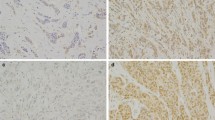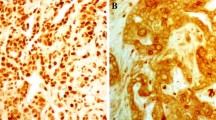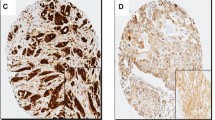Abstract
The mediator of DNA damage checkpoint protein 1 (MDC1) regulates cell cycle checkpoints and recruits repair proteins to sites of double-stranded DNA damage using its BRCA1 carboxy-terminal (BRCT) domains. MDC1 under-expression has been associated with radiosensitivity in cells. The purpose of this study was to evaluate the clinico-pathologic and prognostic significance of MDC1 expression in a cohort of early-stage breast cancer patients treated with breast conservation therapy. Paraffin specimens from 489 women with early-stage breast cancer treated with breast conservation therapy were constructed into tissue microarrays. The arrays were stained for estrogen receptor (ER), progesterone receptor (PR), human epidermal growth factor receptor 2 (HER2), and MDC1. This was correlated with clinico-pathologic factors and outcomes. MDC1 expression was evaluable in 351 cases (72%). Decreased MDC1 expression was found to be correlated with nodal failure (P = 0.05), but not ipsilateral breast relapse-free survival (IBRFS), distant metastasis-free survival (DMFS), or overall survival (OS). Subset analysis in node-negative patients revealed that decreased MDC1 expression predicted for nodal failure (P < 0.01). Our study is the first to assess the clinico-pathologic and prognostic significance of MDC1 expression in patients with early-stage breast cancer treated with lumpectomy and radiotherapy. MDC1 under-expression predicted for nodal failure, but not for IBRFS, DM, or OS. The role of other proteins involved in the DNA damage repair pathway and their effects on MDC1 expression, as well as the level of MDC1 expression in patients with BRCA1 mutations warrant further investigation.




Similar content being viewed by others
References
Haffty BG, Glazer PM (2003) Molecular markers in clinical radiation oncology. Oncogene 22(37):5915–5925
Goyal S et al (2009) Clinicopathologic significance of excision repair cross-complementation 1 expression in patients treated with breast-conserving surgery and radiation therapy. Int J Radiat Oncol Biol Phys 76(3):679–684
Yang Q, Moran MS, Haffty BG (2009) Bcl-2 expression predicts local relapse for early-stage breast cancer receiving conserving surgery and radiotherapy. Breast Cancer Res Treat 115(2):343–348
Goldberg M et al (2003) MDC1 is required for the intra-S-phase DNA damage checkpoint. Nature 421(6926):952–956
Stewart GS et al (2003) MDC1 is a mediator of the mammalian DNA damage checkpoint. Nature 421(6926):961–966
Lou Z et al (2006) MDC1 maintains genomic stability by participating in the amplification of ATM-dependent DNA damage signals. Mol Cell 21(2):187–200
Lou Z et al (2003) Mediator of DNA damage checkpoint protein 1 regulates BRCA1 localization and phosphorylation in DNA damage checkpoint control. J Biol Chem 278(16):13599–13602
Rai R et al (2008) Differential regulation of centrosome integrity by DNA damage response proteins. Cell Cycle 7(14):2225–2233
Bartkova J et al (2007) DNA damage response mediators MDC1 and 53BP1: constitutive activation and aberrant loss in breast and lung cancer, but not in testicular germ cell tumours. Oncogene 26(53):7414–7422
D’Assoro AB et al (2002) Amplified centrosomes in breast cancer: a potential indicator of tumor aggressiveness. Breast Cancer Res Treat 75(1):25–34
Stucki M, Jackson SP (2004) MDC1/NFBD1: a key regulator of the DNA damage response in higher eukaryotes. DNA Repair (Amst) 3(8–9):953–957
Clarke M et al (2005) Effects of radiotherapy and of differences in the extent of surgery for early breast cancer on local recurrence and 15-year survival: an overview of the randomised trials. Lancet 366(9503):2087–2106
Recht A, Houlihan MJ (1995) Conservative surgery without radiotherapy in the treatment of patients with early-stage invasive breast cancer. A review. Ann Surg 222(1):9–18
Haffty BG et al (2006) Locoregional relapse and distant metastasis in conservatively managed triple negative early-stage breast cancer. J Clin Oncol 24(36):5652–5657
Haffty BG, Fischer D, Fischer JJ (1990) Regional nodal irradiation in the conservative treatment of breast cancer. Int J Radiat Oncol Biol Phys 19(4):859–865
Pejavar S, Wilson LD, Haffty BG (2006) Regional nodal recurrence in breast cancer patients treated with conservative surgery and radiation therapy (BCS + RT). Int J Radiat Oncol Biol Phys 66(5):1320–1327
McShane LM et al (2006) Reporting recommendations for tumor marker prognostic studies (REMARK). Breast Cancer Res Treat 100(2):229–235
Inoue K et al (2008) NFBD1/MDC1 stabilizes oncogenic MDM2 to contribute to cell fate determination in response to DNA damage. Biochem Biophys Res Commun 371(4):829–833
Coster G et al (2007) The DNA damage response mediator MDC1 directly interacts with the anaphase-promoting complex/cyclosome. J Biol Chem 282(44):32053–32064
Xu X, Stern DF (2003) NFBD1/MDC1 regulates ionizing radiation-induced focus formation by DNA checkpoint signaling and repair factors. FASEB J 17(13):1842–1848
Nakanishi M et al (2007) NFBD1/MDC1 associates with p53 and regulates its function at the crossroad between cell survival and death in response to DNA damage. J Biol Chem 282(31):22993–23004
Peng A, Chen PL (2003) NFBD1, like 53BP1, is an early and redundant transducer mediating Chk2 phosphorylation in response to DNA damage. J Biol Chem 278(11):8873–8876
Wilson KA, Stern DF (2008) NFBD1/MDC1, 53BP1 and BRCA1 have both redundant and unique roles in the ATM pathway. Cell Cycle 7(22):3584–3594
Gowen LC et al (1998) BRCA1 required for transcription-coupled repair of oxidative DNA damage. Science 281(5379):1009–1012
Xu X et al (1999) Centrosome amplification and a defective G2-M cell cycle checkpoint induce genetic instability in BRCA1 exon 11 isoform-deficient cells. Mol Cell 3(3):389–395
Xu B, Kim S, Kastan MB (2001) Involvement of Brca1 in S-phase and G(2)-phase checkpoints after ionizing irradiation. Mol Cell Biol 21(10):3445–3450
Conflicts of interest statement
The authors report no disclosures or conflicts of interest.
Author information
Authors and Affiliations
Corresponding author
Rights and permissions
About this article
Cite this article
Patel, A.N., Goyal, S., Wu, H. et al. Mediator of DNA damage checkpoint protein 1 (MDC1) expression as a prognostic marker for nodal recurrence in early-stage breast cancer patients treated with breast-conserving surgery and radiation therapy. Breast Cancer Res Treat 126, 601–607 (2011). https://doi.org/10.1007/s10549-010-0960-6
Received:
Accepted:
Published:
Issue Date:
DOI: https://doi.org/10.1007/s10549-010-0960-6




